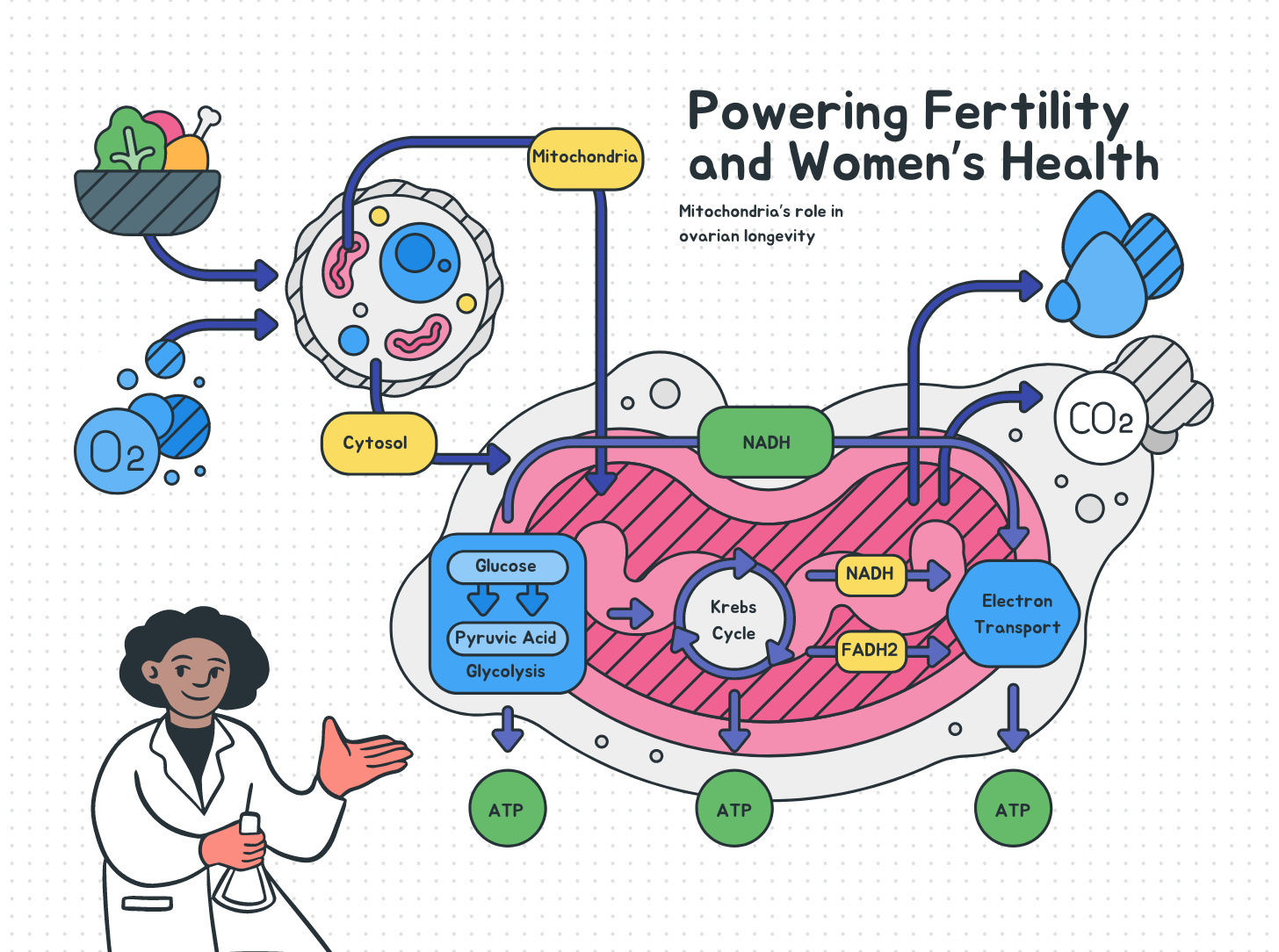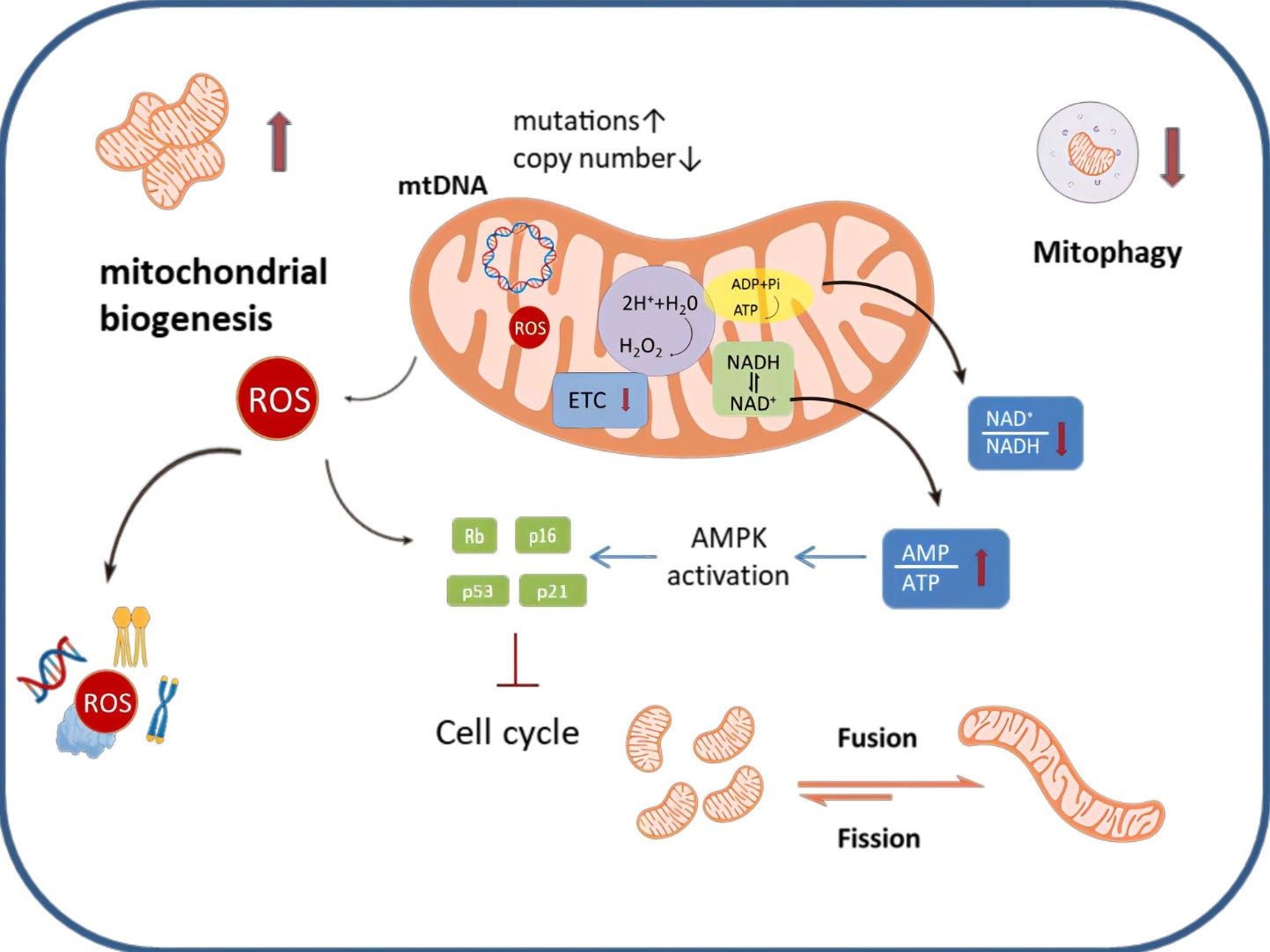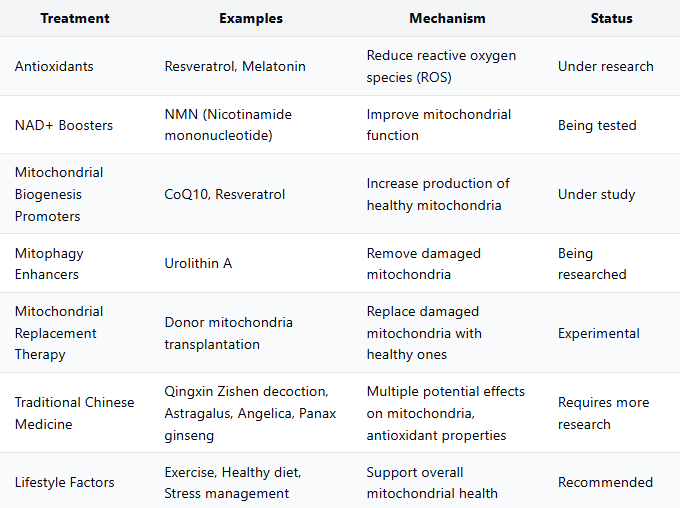Powering Fertility and Women's Health
Mitochondria's role in ovarian longevity
Ovarian aging is a complex biological process where both the quality and quantity of a woman's eggs (oocytes) decrease over time. This process speeds up after age 31, leading to reduced fertility and higher risks of pregnancy complications. As ovarian aging occurs, the body produces less estrogen and progesterone, two key hormones. This causes changes in menstrual patterns, menopausal symptoms like hot flashes and sleep problems, and increased risks of health issues such as cardiovascular disease, osteoporosis, and cognitive decline. The effects of ovarian aging go beyond just reproductive health. It can impact a woman's career, relationships, and overall quality of life. As women live longer but still reach menopause at about the same age, they spend more time in a post-menopausal state. This highlights the need for research into ways to lessen the effects of ovarian aging and support women's health during this transition.
Mitochondrial health plays a crucial role in determining the quality of eggs and ovarian follicles. Mitochondria are the powerhouses of cells, producing energy. Eggs have high energy needs and contain many mitochondria. As women age, these mitochondria can develop problems. They might produce too many harmful reactive oxygen species (ROS), have damaged DNA, or experience disrupted fusion and fission (ways mitochondria combine and divide). When mitochondria don't function properly, it can damage cellular components like lipids, proteins, and DNA. This can lead to reduced ovarian reserves and compromise egg development. Mitochondrial DNA mutations and depletion, which increase with age, worsen mitochondrial dysfunction in ovarian cells. The body has quality control mechanisms for mitochondria, including biogenesis (making new mitochondria), fusion/fission dynamics, and mitophagy (removing damaged mitochondria). When these processes don't work well, damaged mitochondria can build up. This further reduces energy production and increases oxidative stress in the cells.
The health and function of mitochondria directly influence the quality of eggs and ovarian follicles. This has significant implications for a woman's reproductive potential and overall ovarian aging. Scientists are studying ways to maintain mitochondrial health to improve women's reproductive outcomes as they age.
Let's explore some of the exciting treatments scientists are studying to help preserve ovarian health and function as we age. These treatments focus on protecting and improving the work of mitochondria in ovarian cells.
One promising approach is using antioxidants. Remember how we talked about mitochondria producing "pollution" called reactive oxygen species (ROS)? Antioxidants are like special cleaners that can help reduce this pollution. Scientists are looking at compounds like resveratrol, which is found in grapes, and melatonin, which our bodies naturally produce to regulate sleep. These substances might help protect eggs from damage caused by too much ROS.
Another interesting treatment involves boosting levels of a molecule called NAD+. Think of NAD+ as a special fuel that mitochondria need to work properly. As we get older, we tend to have less NAD+ in our bodies. Researchers are testing supplements like NMN (nicotinamide mononucleotide) that can help increase NAD+ levels. This might help mitochondria work better and keep ovaries healthier for longer.
Scientists are also excited about ways to help cells make more healthy mitochondria. This process is called mitochondrial biogenesis. Compounds like CoQ10 and the already mentioned resveratrol might help with this. It's like encouraging the body to build more power plants to keep up with energy demands.
There's also growing interest in a process called mitophagy. This is how cells get rid of old, damaged mitochondria. Researchers are looking at compounds like Urolithin A, which is found in pomegranates, to help boost mitophagy. By clearing out the old, broken mitochondria, there's more room for healthy ones to do their job.
Some scientists are exploring more high-tech solutions. One idea is called mitochondrial replacement therapy. This involves taking healthy mitochondria from a donor and putting them into eggs with damaged mitochondria. It's a bit like changing out old batteries for new ones. While this is still experimental and raises some ethical questions, it shows how far science has come in understanding mitochondria's importance.
Traditional Chinese medicine is providing some interesting leads too. Some herbal mixtures have shown promise in animal studies for improving ovarian function and egg quality. These might work by helping mitochondria in various ways, though more research is needed to understand exactly how.
It's important to note that many of these treatments are still being studied. Scientists need to do more research to make sure they're safe and effective for humans. But they show how much we've learned about the importance of mitochondria in ovarian health.
Beyond these specific treatments, researchers are finding that lifestyle factors can also help preserve ovarian function. Regular exercise, a healthy diet rich in antioxidants, and managing stress all seem to support mitochondrial health throughout the body, including in the ovaries.
All of this research is exciting because it could give women more choices about when to have children. But it's about more than just fertility. By understanding how to keep ovaries healthy, we're learning important lessons about aging in general. This could lead to ways to help everyone stay healthier for longer.
It's amazing to think that by focusing on tiny mitochondria, we might unlock secrets to big questions about health and longevity. Every day, scientists are learning more, bringing us closer to new ways to support reproductive health and overall well-being as we age.
References
1. Marchante, M., Ramirez-Martin, N., Buigues, A., Martinez, J., Pellicer, N., Pellicer, A., & Ruiz-Alonso, M. (2023). Deciphering reproductive aging in women using a NOD/SCID mouse model for distinct physiological ovarian phenotypes. Aging, 15, 10856-10874.
2. Wu, J., Liu, Y., Song, Y., Wang, L., Ai, J., & Li, K. (2022). Aging conundrum: A perspective for ovarian aging. Frontiers in Endocrinology, 13.
3. Dong, L., Teh, D.B.L., Kennedy, B.K., & Huang, Z. (2023). Unraveling female reproductive senescence to enhance healthy longevity. Cell Research, 33, 11-29.
4. San-Millán, I. (2023). The key role of mitochondrial function in health and disease. Antioxidants, 12(4), 782.
5. May-Panloup, P., Boucret, L., Chao de la Barca, J.-M., Desquiret-Dumas, V., Ferré-L'Hotellier, V., Morinière, C., ... & Reynier, P. (2016). Ovarian ageing: the role of mitochondria in oocytes and follicles. Human Reproduction Update, 22(6), 725-743.
6. Kasapoglu, I., & Seli, E. (2020). Mitochondrial dysfunction and ovarian aging. Endocrinology, 161(2).
7. Liu, M., Yin, Y., Ye, X., Zeng, M., Zhao, Q., Keefe, D. L., & Liu, L. (2013). Resveratrol protects against age-associated infertility in mice. Human Reproduction, 28(3), 707-717.
8. Yang, Q., Cong, L., Wang, Y., Luo, X., Li, H., Wang, H., ... & Ge, H. (2020). Increasing ovarian NAD+ levels improve mitochondrial functions and reverse ovarian aging. Free Radical Biology and Medicine, 156, 1-10.
9. Wang, H., Xu, J., Li, H., Chen, W., Zeng, X., Sun, Y., ... & Ge, H. (2023). Alpha-ketoglutarate supplementation ameliorates ovarian reserve and oocyte quality decline with aging in mice. Molecular and Cellular Endocrinology, 571, 111935.
10. Chen, Y., Wu, Y., Zhou, Y., Teo, Y.Q., Miao, T., Lei, W., ... & Wu, X. (2023). The delaying effect of Qingxin Zishen decoction on ovarian aging: Examining regulation of ovarian mitochondria apoptosis in aged rats. Experimental Gerontology, 182(1).
11. Liu, Y., Weng, W., Gao, R., & Liu, Y. (2019). New insights for cellular and molecular mechanisms of aging and aging-related diseases: Herbal medicine as potential therapeutic approach. Oxidative Medicine and Cellular Longevity, 2019, 1-25.





